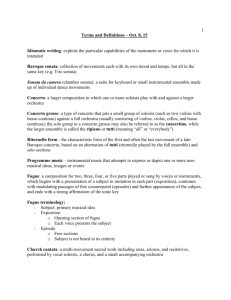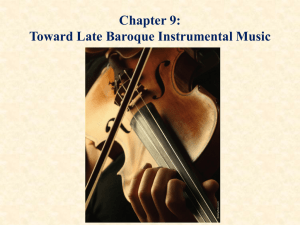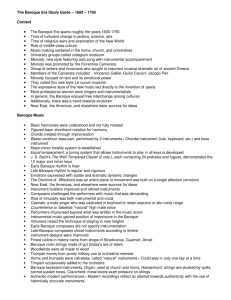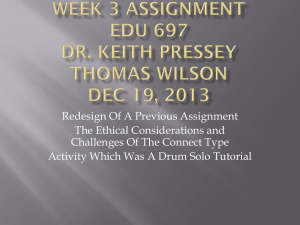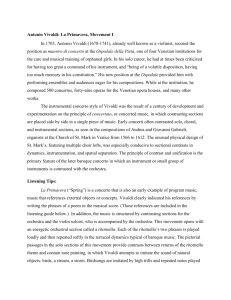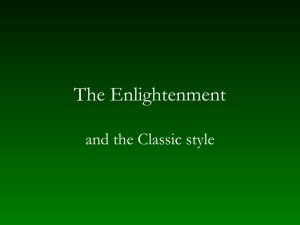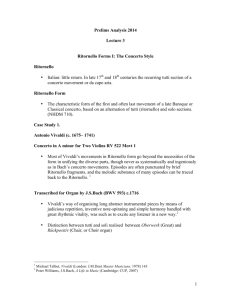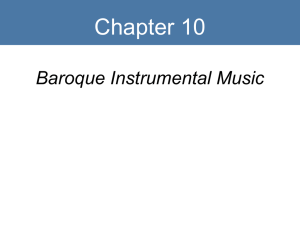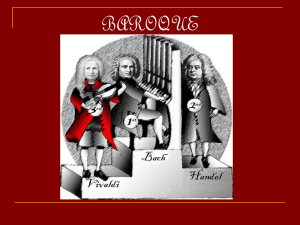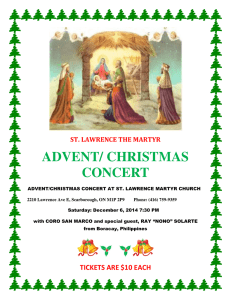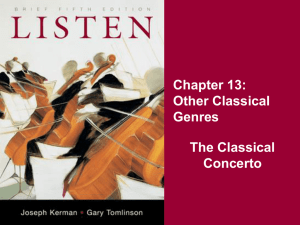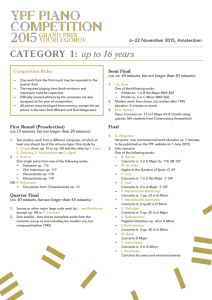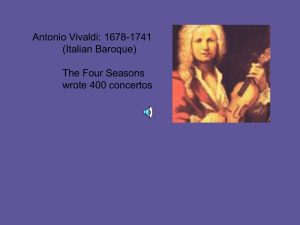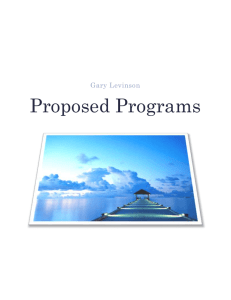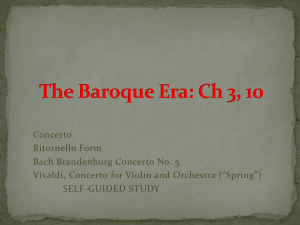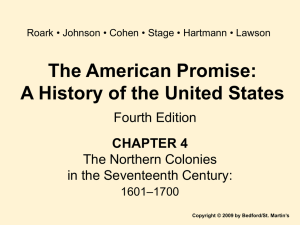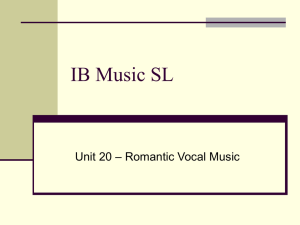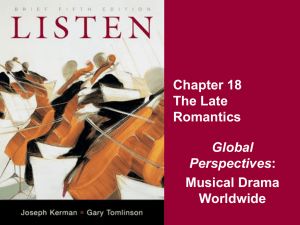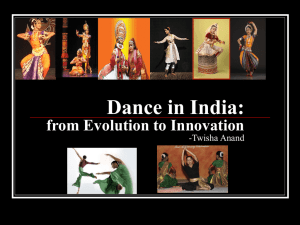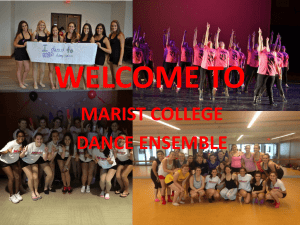Opera in 17th-century France
advertisement
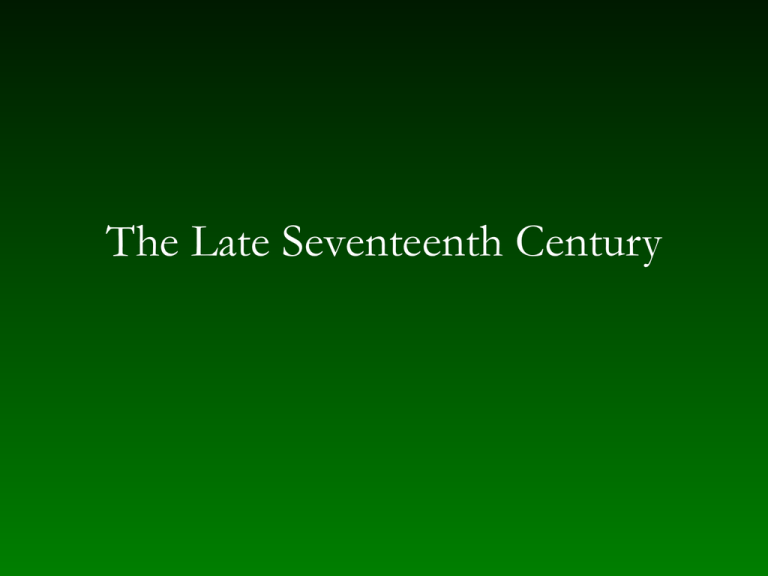
The Late Seventeenth Century Opera in seventeenth-century France • Absolute monarchy — established by Cardinal Richelieu under Louis XIII • Académies – 1635 Académie française (for belles lettres) set up by Richelieu — rationalistic, idealistic, classicistic in sense of restraint, balance – Académie de musique (1669) • Ballet de cour – social, participatory with courtiers as dancers – danced in center space in open hall – included instrumental music, spoken narrative and dialogue, airs • Opera’s arrival in France – Italian works during regency of Anne of Austria (1643–1653) – nationalism — exploited by librettist Pierre Perrin (ca. 1620–1675) under Louis XIV Jean-Baptiste Lully (1632–1687) • Florentine, moved to Paris 1646 • Instrumental composer to Louis XIV from 1653 – member of existing Vingt-quatre violons du roi – Petits violons (sixteen, later twenty-one) under Lully from 1656 set new performance standards – superintendent of music from 1661 • Comédies-ballets with Molière 1663–1672, e.g., Le bourgeois gentilhomme 1670 – fused music, dance, poetry — developing style – influence of Italian pastoral operas, French ballet de cour • 1672 — took over Académie de musique — complete control of musical life in France Tragédies lyriques • Lully and Philippe Quinault (1635–1688) • Mythological plots with allegorical allusions to France and king • French style – – – – – – five acts — Classic model from Greek antiquity emphasis on ballet derived from ballet de cour tradition more chorus than contemporary Italian opera spectacle — machines, sets récitatif — carries action, carefully measured, simple air modeled on French air de cour — nondramatic, often employs dance rhythms and forms – functions of instrumental music • articulative — especially overture • dramatic — accompaniment to singing • dance accompaniments English music in the late seventeenth century • Isolation — especially under Cromwell and Commonwealth 1649–1660 • Restoration began to recover court following French model English church music in the seventeenth century • Beginning of century continued music of English Reformation – Services – full and verse anthems • Church musicians abolished under Puritan regime • Restoration recovered choral music tradition, including concerted compositions Instrumental music in England • Keyboard tradition from sixteenth century – dances – variation sets • Ensemble music – fantasy (fancy) for consort of viols – later, Italian-style sonatas Musical drama during the Restoration period • Theater music tradition of court masque – – – – recitatives songs choruses dances • Theater suppressed during Commonwealth — concerts still permitted • Opera after the Stuart Restoration still very limited Henry Purcell (1659–1695) • Time of Stuart Restoration, worked in court and Westminster Abbey • Sacred works associated with church employment — anthems, services • Dramatic music for court milieu – opera Dido and Aeneas – semiopera, e.g., The Fairy Queen • Odes and welcome songs — royal welcomes, weddings, birthdays, St. Cecilia’s Day • Songs • Instrumental — keyboard, ensemble (fantasies, sonatas, etc.) Spanish opera in the seventeenth century • Based on pastoral court entertainment tradition — use of mythical, allegorical plots • Solo singing – all female in leading parts — except for comic male peasant – not separated into distinct style of recitative and aria but used strophic songs for both dialogue and affective moments • Spanish instrumentation — continuo uses harp and guitar • Choruses in familiar style Neapolitan opera in the late seventeenth century • Naples as focus of stylistic progress in Italy • Sharp distinctions – serious vs. comic scenes — later to be split away – solo almost completely displaces chorus, mostly displaces ensembles – recitative extremely differentiated from aria — differentiated as simple, accompagnato; arioso Da capo aria design A B A Ritornello home key Solo modulating Ritornello contrast key Solo modulating Ritornello home key Solo modulating da capo — ornamented in performance Cantata • Chamber vocal genre (cubicularis) for – voice (possibly voices) – continuo (possibly obbligato instruments) • Multiple movements • Vocal styles of opera – recitative – aria Later seventeenth-century instrumental genres Organ music, Suite, Sonata, Concerto German organ music in the late seventeenth century German organ music in the late seventeenth century Two classifications of organ compositions • Frei — figurational material; free from contrapuntal texture – prelude, toccata, etc. • Gebunden — based on established melodic material, follows contrapuntal rules – chorale-based pieces – fugues Chorale settings for organ • Chorale fugue — chorale melody treated in fugal texture • Chorale fantasia — extended elaborations of each phrase with repetitions and interruptions in c.f. • Chorale prelude — one more-or-less continuous statement of chorale melody as c.f. – c.f. with or without ornamentation — ornamentation usually only if c.f. is soprano – accompaniment either independent or derivative — Vorimitation • Chorale partita — series of short chorale settings in contrasting styles – alternatim usage in service — organ, choir, congregation Fugue • Antecedents – sixteenth-century imitative pieces based on vocal models — ricercar (from motet) and canzona (from chanson) – early seventeenth-century monothematic fantasia or ricercar • Theoretical and stylistic principles in mature fugue – monothematicism – subjects more instrumental in melodic and rhythmic profile, unlike ricercar and fantasia – tonal answer – countersubject – tonal unity and plan for entire piece – pedal point — especially approaching final cadence – stretto, especially for end of piece The French keyboard suite (ordre) • Importance of dance — court ballet tradition • Harpsichord — intimate style suited to taste of courtly amateurs • Rhythm — derived from dance styles • Melody — agréments; ornamented doubles • Forms – binary dance form — variety of midpoint cadence choices – rondeau Standard order of dances in the late seventeenth-century suite • • • • Derived from publication of suites by Johann Jacob Froberger (1616–1667) Allemande — duple meter, moderate tempo Courante — flowing triple meter (often with hemiola) Sarabande — slow triple meter, emphasis on second beat 2 of the measure Gigue — fast compound meter Two important French suite composers • Elisabeth-Claude Jacquet de la Guerre (1665–1729) • François Couperin "le grand" (1668–1733) — often used descriptive titles rather than dance names, turning dance movements into character pieces Sonata • Scoring – violin(s) or other melodic instruments and b.c. – instrumental idiom, not vocal style • Ensembles – trio sonata — duet and b.c. • most popular • combines clarity of b.c. texture with polyphonic interest – solo sonata — solo and b.c. • allows for more virtuosity • Major composer — Arcangelo Corelli (1653–1713) Sonata types • Sonata da camera (chamber sonata) – stylized dances — actually a dance suite • Sonata da chiesa (church sonata) – abstract movements (at least ostensibly) – alternating tempos, usually slow-fast-slow-fast Concerto • Derived from sonata by reinforcing some passages with multiple instruments • Two major composers – Giuseppe Torelli (1658–1709) —established structural principles – Antonio Vivaldi (1678–1741) — worked out types of material to exploit principles of form Concerto types • Ripieno (full) concerto — uses all instruments freely • Solo concerto — solo vs. ripieno group • Concerto grosso — concertino group (often trio group) vs. ripieno Form in the Baroque concerto • Three movements (usually) — fast, slow, fast • Outer movements usually in ritornello form: Ritornello Solo Ritornello Solo Ritornello Tutti Solo and b.c. Tutti Solo and b.c. Tutti Home key →→→ Contrast key →→→ Home key Questions for discussion • How did political structures affect musical life and express themselves through musical style in the late seventeenth century? • Why would it be appropriate to describe a large Italian opera aria as a concerto movement for voice? What significant differences are there between the two structures? • How did the idea of affective expression and of key center support large forms in instrumental and vocal music in the seventeenth century?
